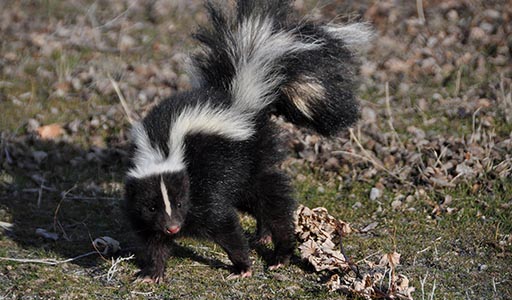Skunks

Skunk Information
There are four species of skunk in the United States:
- striped skunks
- hooded skunks
- hog-nosed skunks
- spotted skunks
All are infamous for their ability to spray an incredibly pungent, nauseating liquid at potential predators as a defense mechanism. This liquid is potent enough to cause temporary blindness, and, if the wind is right, can be smelled over a mile away.
Fortunately, it is rare to run into a skunk, and even rarer to be sprayed by one, as they are mild-mannered, nocturnal, and will usually spray only when attacked or cornered.
Skunks are beneficial in some ways for farmers and gardeners, as their diet consists largely of agricultural pests. But they can still be a problem for homeowners, usually during mating season, birthing season, or during pre-hibernation. During these times, skunks are searching for a denning site, and all too often wind up in human homes.

What does a Skunk look like?
Skunks’ most distinctive feature is their incredibly luxurious fur. It is usually black and white, although some appear brown or grey. All skunks have stripes, even from birth. They may have a single, thick stripe across their back and tail, two thinner stripes, or, in the case of the spotted skunk, a series of white spots and broken stripes. They are anywhere from 16-37 inches long, and range in weight from a little over one pound (spotted skunks) to eighteen pounds (hog-nosed skunks). Their bodies are somewhat long, with comparatively short, muscular legs with long front claws for digging. Skunks have five toes on each foot, which makes their tracks look vaguely like miniature bear tracks.

What does a Skunk eat?
Skunks are omnivores, meaning they eat pretty much whatever food comes their way. Common meals for a skunk are insects, larvae, grubs, earthworms, lizards, frogs, snakes, and eggs. They are also known to eat berries, roots, leaves, nuts, and, in settled areas, garbage that’s been left out by humans. Infrequently, skunks may even act as scavengers, eating bird or rodent carcasses that have been left by other animals, like dogs or cats.

Skunk habitats
Skunks have a wide variety of habitats in the US that includes deserts, forests, and mountains. They prefer areas with a mixture of woods, brush and open fields broken up by wooded ravines and rocky outcrops. Skunks use underground dens year-round for daytime resting, hiding, as well as birthing and rearing young. These dens are usually located under wood and rock piles, buildings, porches, rock crevices, culverts, and hollow trees. Spotted skunks are excellent climbers and may even use an attic or a hayloft as a den.
Skunk Breeding Season
Striped skunks breed from February through March, while spotted skunks breed from September through October. Solitary except during mating season, males are promiscuous and may mate with several females. Spotted skunks experience something called delayed implantation, which is where the fertilized egg doesn’t attach to the uterine wall for a period of time after breeding.
As a result, striped and spotted skunks give birth around the same time, in late April or May. Females of both species give birth to four to five young in an underground nest lined with dried vegetation.
At around 60 days old, the mother leads her young out at dusk to learn to forage and hunt. At three months old, the skunks are almost fully grown and virtually independent.
Skunk Lifespan
Skunks usually live one to six years in the wild and can live as long as 10 years in captivity.
Skunk’s natural predators include foxes, bobcats, cougars, and the occasional large owl. Domestic dogs will also readily kill skunks. Unfortunately, many skunks die as a result of human interaction: road kills, trapping, shooting, and killing by farm chemicals are all too common.
Identifying Skunk Scat
Waste left behind by cats and skunks has a similar appearance. Skunk scat is tube-shaped with blunt ends and a smooth surface. The only way to differentiate between feline and skunk feces is to look inside. Unlike cats, skunks eat fruit, berries, and insects, which are visible in their scat.
Skunk Tracks Identification
With their thick black fur and white stripes or spots, skunks have a distinctive appearance. However, the footprints they leave behind aren’t as easy to distinguish from other animals. Raccoon and skunk tracks are similar, as both pests have five toes.
Knowing which animal is infesting the property is crucial to effective removal. Because both are nocturnal, homeowners are unlikely to actually see them during the day. As a result, people may need to rely on tracks and other signs to decide whether they have a skunk or raccoon problem.
Skunk Control and Prevention
As is the case with many animals, the best way to live harmoniously with skunks is to leave them be.
Four Ways to Control Skunks in Your Yard
- Do not feed skunks.
Feeding skunks is not advised, as this can cause them to lose their fear of humans and cause many skunks to concentrate in a single area, which can heighten the risk of diseases and parasites being spread. To this end, if you have pets, feed them inside, or clean up any spilled or uneaten food before dusk. Keep pet food stored in secure containers.
- Prevent access to denning sites
It’s also important for homeowners to prevent access to denning sites, as skunks will readily den under houses, sheds, or porches if given the chance. Close off these areas with ¼-inch hardware cloth, boards, or metal flashing. Make all connections flush and secure, and you’ll keep out smaller animals like mice and rats, too.
- Protect your lawn.
Lawns—especially newly created ones—are immensely attractive to skunks, as they tend to be heavily watered and loaded with worms and grubs. Skunks dig small holes where grubs are located, which can make your lawn ugly quite quickly. To prevent this, lay down 1-inch mesh chicken wire, securing it with stakes or heavy stones. Alternatively, sprinkle cayenne pepper or commercial dog and cat repellent over dig-prone areas during dry weather.
- Call a professional.
While skunks are usually harmless, they can be a real nuisance and are one of the most common U.S. animals to carry rabies. We advised to not remove them directly. If you’re being consistently bothered by skunks, or you think one might be denning under your home or deck, you may consider reaching out to a professional service such as Trutech for a swift resolution to your situation.
Skunks are not aggressive. Their spray is the biggest threat they pose to people and pets. Skunks are one of the main vector species for the rabies virus. If you have a skunk on your property, avoid it!
Skunks spray as a defense mechanism. Skunk spray has a very potent and displeasing smell. Because it consists of organic compounds containing sulfur, the spray has a very sulfurous smell. The spray’s intensely pungent odor comes from thiol, a chemical compound mainly composed of sulfur and hydrogen.
A skunk can spray up to ten feet.
A skunk can spray up to six times in succession.


